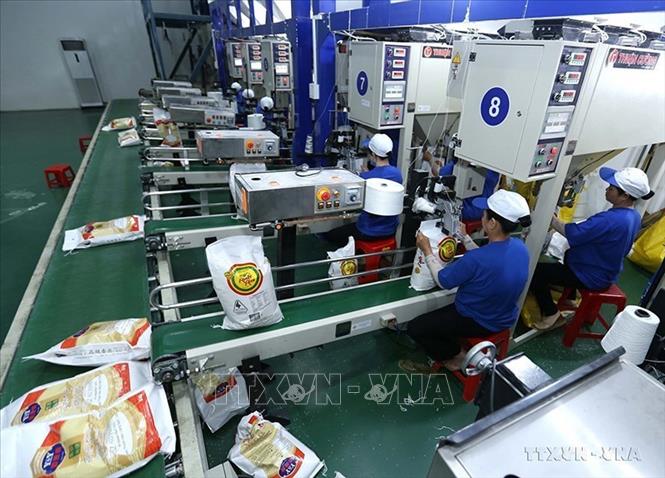
Rice packaging line at Trung An Hi-tech Agriculture Joint Stock Company (Can Tho). Photo courtesy: Vu Sinh/VNA
According to statistics from Singapore’s Enterprise Registrar Office, Vietnam’s rice exports to the Singapore market in the first three months of 2024 continued to grow very well, reaching a value of approximately SGD 36.15 million, an increase of 80.46% compared to the same period in 2023.
The decline of groups such as regular brown rice and white rice was offset by the very strong growth of glutinous rice groups (value of SGD 3.79 million, up 221.76%), milled or husked fragrant rice (value of SGD 18.06 million, up 291.17%) and broken rice (value of SGD 575 thousand, up 111.4%).
Notably, besides Vietnam’s traditional strength, white rice, two other groups of glutinous rice and milled or husked fragrant rice are also emerging to dominate the market share in Singapore, reaching 80.08% and 73.33%, respectively. This is the main factor pushing Vietnam past Thailand and India to become the country with the largest market share of rice in Singapore.
In addition, India is also a country that almost completely dominates the market with characteristic products of parboiled rice (accounting for 99.29%) and milled or husked basmati rice (accounting for 95.66%). With the remaining rice products, Thailand mostly accounts for the largest market share, namely: hom mali brown rice (98.26%), hom mali white rice (96.83%), broken rice (68.16%). For the group of regular brown rice, Japan is the country with the largest market share (71.72%).
According to the Vietnam Trade Office in Singapore, Thailand, India, and Japan are currently Vietnam’s biggest competitors in the Singapore rice market. India (the country with the largest market share of white rice, a type of rice in which Vietnam has an advantage) issued an export ban on all rice varieties except basmati from July 20, 2023, which has been well utilized by Vietnamese businesses to increase market share and export value to Singapore.
In particular, Vietnamese businesses seem to have successfully expanded the market to other items such as glutinous rice and milled or husked fragrant rice. However, this trend still needs more time and effort to ensure the sustainable maintenance of the largest partner position. Besides, Vietnamese businesses need to continue to improve their competitiveness and ensure the quality of rice products.
Furthermore, the Vietnam Trade Office in Singapore has been displaying products, increasing the presence of Vietnamese rice in the area, and supporting delegations from Singapore to participate in rice promotion activities in Vietnam. However, the Vietnam Trade Office in Singapore also pointed out that countries such as Thailand, Japan, and India are also very interested in investing in promoting product image as well as having agreements with import and distribution units on keeping the name and brand of goods. However, Vietnamese rice exporting businesses, which have weak potential and rarely invest in promoting and introducing products, do not want importers and distribution systems in Singapore to use Vietnamese product brands, mainly importing raw rice and then packing the designs, packaging, and local brands of Singapore for easy consumption in the market.
Citing statistics from the Singapore Enterprise Registrar Office, the Vietnam Trade Office in Singapore said that in the first three months of 2024, the total import value of rice from the world of the Singapore market increased sharply by 23.86% compared to the same period, reaching nearly SGD 112.9 million. In terms of volume, the total imported quantity of 9 major rice varieties (HS10062010, HS10062090, HS10063030, HS10063040, HS10063091, HS10063099 and HS10064090, HS10063050, HS10063070) is estimated to reach approximately 110,636 tons, up 6.15% compared to the same period in 2023.
In terms of market share structure of rice items, white rice holds the largest market share (25.09%), followed by milled or husked fragrant rice (21.82%), parboiled rice (19.75%), and hom mali white rice (16.43%). Other rice products share the remaining segments.
To increase market share and sustainably maintain the leading position, competing with rice products from India and Thailand, the Vietnam Trade Office in Singapore recommends the support and contribution of ministries, sectors, localities, industry associations, and businesses. On the other hand, it is necessary to increase trade promotion, promote product brands, business brands, increase the presence of products in the area, and maintain and ensure the quality of goods. Besides, the signing of the Memorandum of Understanding (MOU) on rice between Vietnam and Singapore could be an effective tool to maintain the number one position of Vietnamese rice products in the Singapore market.




































